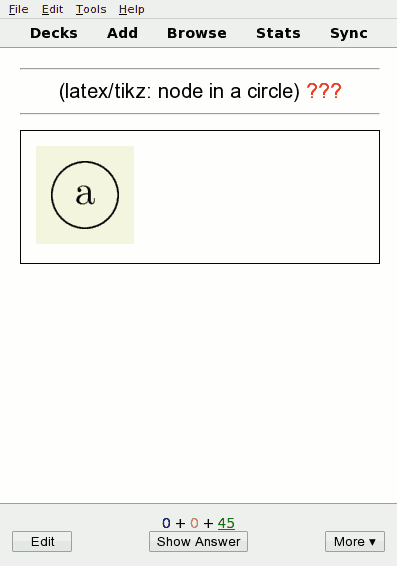A collection of small code examples, which can be used for learning syntax and idiosyncrasies. You can use the examples to memorize features of programming languages. A spaced repetition software (SRS) such as Anki might help with that task.
Currently there are examples for
- python3
- latex
- rust
- web development (web_dev)
Screenshot of a flash card in Anki:
Some examples are more difficult to understand. Therefore this project also aims to provide a method to sort them according to their level (difficulty). To assign a level to examples interactively, you can use the following command:
python3 level_assessment.py <example-files>
The command will start a browser. You are presented with two cards. You select which of them is easier.
All decisions are stored in output/level_data.json.
The script level_estimate.py calculates a level based on these decisions.
The script generate_cards.py converts the examples to flash cards.
It uses the levels (see previous section) to sort the cards by difficulty.
To generate the cards, use the command
python3 generate_cards.py <example-files> > <output-file>
Problems are reported to standard error. The output is a file in the TSV (tab separated value) format. Its columns are
- example: a unique identifier
- description
- pre: code that precedes the code that the user has to remember
- step: this is the code that the user needs to know
- post: code that shows how to apply the result
- explanation: give more detail for for non-obvious/counter-intuitive answers
- Choose File -> Import
- Select the right type and deck (this project might provide a template at a later stage)
- "Fields separated by: Tab"
- "Update existing notes when first field matches"
- Activate "Allow HTML in fields"
- Map the columns
- Click on "Import"
Note that the order of already imported cards does not change. This could be achieved by an Anki add-on. Any help is appreciated.
You can contribute in several ways:
- give feedback on usability
- provide examples for existing programming languages
- add new programming languages
- write addons for better integration with SRS (especially Anki)
- ...
Any contribution shall be licensed by the same license as the project, see the license section below.
Logos:
- Rust: https://www.rust-lang.org/en-US/legal.html
- Python: https://www.python.org/community/logos/
- Git: https://git-scm.com/downloads/logos
This project is licensed under the AGPL, version 3 (LICENSE or https://www.gnu.org/licenses/agpl-3.0.en.html).
The examples are provided WITHOUT ANY WARRANTY; without even the implied warranty of MERCHANTABILITY or FITNESS FOR A PARTICULAR PURPOSE. The use of the logos of the programming languages (Python, Rust, ...) is for visual purposes only. It does not imply any endorsement by the respective projects.

